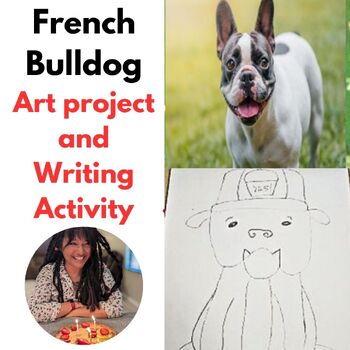French Bulldog Drawing Lesson Writing Activity
The Gifted Learner
1.6k Followers
Grade Levels
K - 3rd
Standards
CCSSK.MD.A.2
CCSS2.MD.A.1
CCSSK.G.A.1
CCSSK.G.A.2
CCSSK.G.B.4
Formats Included
- PDF
Pages
22 pages
The Gifted Learner
1.6k Followers
Description
In this lesson, your students will learn the basics of line drawing and create their own adorable French Bulldog artwork. Using simple shapes and lines, students will create a unique and playful piece of art. This lesson is perfect for introducing basic drawing techniques and inspiring creativity in your classroom. This lesson is so fun - who doesn't love dogs?
But that's not all! Here are four ways you can incorporate this lesson into other subjects in your elementary school classroom:
- Writing: After students have completed their French Bulldog artwork, have them write a short story or descriptive paragraph about their creation. Encourage them to use vivid language and sensory details to bring their artwork to life.
- Science: Use the French Bulldog art lesson as a starting point for a lesson on animal adaptations. Discuss the unique physical features of French Bulldogs and how these adaptations help them survive in their environment.
- Math: Challenge students to create a grid drawing of their French Bulldog. Use graph paper to create a grid and guide students in creating a larger-scale, more detailed version of their artwork.
- Social Studies: Incorporate French culture into your lesson by discussing the history of French Bulldogs and their place society.
What you will find inside the lesson:
- Teacher prompts for you to read as you give the lesson making it EASY to teach!
- Brief discussion of each topic that is simple and easy to comprehend
- Questions to ask the students about the art
- Step by step DETAILED instructions for an art project with FULL COLOR pictures.
- INSTRUCTIONS ON HOW TO CONFORM THIS LESSON TO COMMON CORE STANDARDS
- Art work to show as examples
- Comprehension questions Worksheet for you to extend the learning that feature key facts about each art project
- Word search and coloring page for fast finishers
- Worksheet where students have the opportunity to give you feedback about the projects
Make sure to click the GREEN STAR near my store name so that you can stay in touch with my store. I create new lessons every week.
Total Pages
22 pages
Answer Key
N/A
Teaching Duration
45 minutes
Last updated Mar 4th, 2017
Report this resource to TPT
Reported resources will be reviewed by our team. Report this resource to let us know if this resource violates TPT’s content guidelines.
Standards
to see state-specific standards (only available in the US).
CCSSK.MD.A.2
Directly compare two objects with a measurable attribute in common, to see which object has “more of”/“less of” the attribute, and describe the difference. For example, directly compare the heights of two children and describe one child as taller/shorter.
CCSS2.MD.A.1
Measure the length of an object by selecting and using appropriate tools such as rulers, yardsticks, meter sticks, and measuring tapes.
CCSSK.G.A.1
Describe objects in the environment using names of shapes, and describe the relative positions of these objects using terms such as above, below, beside, in front of, behind, and next to.
CCSSK.G.A.2
Correctly name shapes regardless of their orientations or overall size.
CCSSK.G.B.4
Analyze and compare two- and three-dimensional shapes, in different sizes and orientations, using informal language to describe their similarities, differences, parts (e.g., number of sides and vertices/“corners”) and other attributes (e.g., having sides of equal length).


